There are a lot of reasons to be pretty dour about 2020 and the months to come, but this isn’t the place for that. Despite periods in which ringing was restricted to our gardens, curtailed by group size limits, and Covid related decreases in group funding; 2020 was a fantastic year of ringing for us and was one of the groups most productive years on record.
2020 saw us collect 8180 records of 6365 unique individuals consisting of 5540 birds ringed, 2199 retraps/controls, and 441 sightings (metal or colour ring reads in the field). It was also the most diverse year with a total of 79 species recorded, 73 of which were ringed, 3 were only recorded as retraps/controls and 3 came only from sightings. 3 species were firsts for our group: Little Grebe, Water Pipit, and Whinchat, and several others were the first the group have caught for many years such as Tawny Owl, Coot, Herring Gull, and Little Owl amongst others. Whilst it may have been a diverse year in terms of number of species, as much of our ringing is based at woodland feeders (particularly in the winter), Blue Tits romp home and take the top spot once again with ease.
Monthly captures, shaded region was full lockdown period with ringing restricted to gardens
| Species | New | Retraps/ Controls | Sightings | Total |
|---|---|---|---|---|
| Blue Tit | 1134 | 943 | 0 | 2077 |
| Lesser Redpoll | 549 | 2 | 0 | 551 |
| Reed Warbler | 438 | 19 | 0 | 457 |
| Swallow | 407 | 3 | 0 | 410 |
| Great Tit | 376 | 507 | 0 | 883 |
| Goldcrest | 355 | 8 | 0 | 363 |
| Sedge Warbler | 330 | 15 | 0 | 345 |
| Greenfinch | 237 | 44 | 0 | 281 |
| Chaffinch | 226 | 59 | 0 | 285 |
| Goldfinch | 165 | 16 | 0 | 181 |
| Reed Bunting | 159 | 6 | 0 | 165 |
| Blackbird | 142 | 76 | 6 | 224 |
| Long-tailed Tit | 132 | 142 | 0 | 274 |
| Robin | 113 | 76 | 1 | 190 |
| Mute Swan | 95 | 50 | 329 | 474 |
| Wren | 68 | 9 | 0 | 77 |
| Bearded Tit | 59 | 20 | 0 | 79 |
| Dunnock | 56 | 70 | 0 | 126 |
| Blackcap | 50 | 1 | 0 | 51 |
| Chiffchaff | 41 | 6 | 0 | 47 |
| Coal Tit | 30 | 82 | 0 | 112 |
| Meadow Pipit | 28 | 0 | 0 | 28 |
| Pied Wagtail (yarrellii) | 47 | 0 | 0 | 47 |
| Starling | 21 | 0 | 0 | 21 |
| Cetti's Warbler | 20 | 0 | 0 | 20 |
| House Sparrow | 19 | 0 | 0 | 19 |
| Brambling | 16 | 1 | 0 | 17 |
| Skylark | 15 | 2 | 0 | 17 |
| Black-headed Gull | 15 | 1 | 50 | 66 |
| Redwing | 15 | 0 | 0 | 15 |
| Sand Martin | 14 | 0 | 0 | 14 |
| Mallard | 13 | 2 | 15 | 30 |
| Great Spotted Woodpecker | 11 | 4 | 0 | 15 |
| Woodcock | 11 | 3 | 0 | 14 |
| Woodpigeon | 10 | 1 | 0 | 11 |
| Willow Warbler | 9 | 1 | 0 | 10 |
| Song Thrush | 9 | 0 | 0 | 9 |
| Treecreeper | 8 | 4 | 0 | 12 |
| Collared Dove | 8 | 0 | 0 | 8 |
| Sparrowhawk | 6 | 1 | 0 | 7 |
| Linnet | 6 | 0 | 0 | 6 |
| Yellow Wagtail | 6 | 0 | 0 | 6 |
| Jack Snipe | 5 | 2 | 0 | 7 |
| Green Woodpecker | 5 | 0 | 0 | 5 |
| Greylag Goose | 5 | 0 | 10 | 15 |
| Bullfinch | 4 | 3 | 0 | 7 |
| Siskin | 4 | 1 | 0 | 5 |
| Garden Warbler | 4 | 0 | 0 | 4 |
| Lesser Whitethroat | 4 | 0 | 0 | 4 |
| Water Pipit | 4 | 0 | 0 | 4 |
| Marsh Tit | 3 | 8 | 0 | 11 |
| Jay | 3 | 2 | 2 | 7 |
| Canada Goose | 3 | 1 | 7 | 11 |
| Stonechat | 2 | 1 | 0 | 3 |
| Coot | 2 | 0 | 0 | 2 |
| Kingfisher | 2 | 0 | 0 | 2 |
| Lapwing | 2 | 0 | 0 | 2 |
| Little Owl | 2 | 0 | 0 | 2 |
| Redstart | 2 | 0 | 0 | 2 |
| Stock Dove | 2 | 0 | 0 | 2 |
| White Wagtail (alba) | 1 | 1 | 0 | 2 |
| Common Redpoll | 1 | 0 | 0 | 1 |
| Firecrest | 1 | 0 | 0 | 1 |
| Grey Wagtail | 1 | 0 | 0 | 1 |
| Herring Gull | 1 | 0 | 4 | 5 |
| Little Grebe | 1 | 0 | 0 | 1 |
| Magpie | 1 | 0 | 0 | 1 |
| Moorhen | 1 | 0 | 0 | 1 |
| Snipe | 1 | 0 | 0 | 1 |
| Tawny Owl | 1 | 0 | 0 | 1 |
| Whinchat | 1 | 0 | 0 | 1 |
| Whitethroat | 1 | 0 | 0 | 1 |
| Yellowhammer | 1 | 0 | 0 | 1 |
| Nuthatch | 0 | 4 | 0 | 4 |
| Grasshopper Warbler | 0 | 1 | 0 | 1 |
| Kestrel | 0 | 1 | 0 | 1 |
| Barnacle Goose | 0 | 0 | 15 | 15 |
| Lesser Black-backed Gull | 0 | 0 | 1 | 1 |
| Turnstone | 0 | 0 | 1 | 1 |
| 5540 | 2199 | 441 | 8180 |
Captures of most species were up from last year as a result of increased effort and improved understanding of how to work the sites from those of us who joined the group relatively recently, but also reflect trends seen nationally such as the eruption of Lesser Redpoll this year that saw us catch 551 (for reference only 204 were caught across the entirety of Norfolk in 2019).
The group joined three colour ringing projects this year to improve on the scientific outputs of our work, whilst the existing Jay colour ringing project has had limited success (perhaps unsurprisingly, but if you don’t try you’ll never succeed). The most prolific of these projects has been the Norwich Swan Project, which has seen us colour ring 124 Mute Swans across Norwich and generate over 500 sightings since we started in July. We also started colour ringing Black-headed Gulls and whilst we only catch modest numbers (15 adults caught by hand and a handful of chicks that were metal ringed on non-UEARG rings), we hope to build upon this in the coming years. Finally, we joined the national Water Pipit colour ringing project after catching two individuals at Cantley in late Autumn, and have subsequently colour ringed a further two individuals. Please keep an eye out for any colour ringed birds and report sightings, however menial you think they may be.
Water Pipit
Data will continue to come in over the next months for birds we have controlled in 2020 or have been recovered elsewhere, but in total we caught 16 controls this year (excluding Mute Swan controls from a local ringer outside our group that is also active in Norwich and local RSPCA rescue birds) and have had 14 recoveries so far (excluding colour ring sightings). We’ve also had 63 >1km movements between our own sites but these were mainly movements of colour ringed Mute Swans. Beyond those Swan movements, we also record several movements between Charter Wood and UEA Campus (~3km). Here’s a map of 2020 controls and recoveries we have data for so far, excluding Mute Swans:
This year we ringed at 34 sites across Norfolk (and a little bit of Suffolk), but the vast majority (77%) of records come from just 5 main sites (Charter Wood, UEA Campus, Horsford Wood, Cantley Beet Factory, and Waxham). Charter Wood, UEA Campus and Horsford Wood are all woodland feeder sites primarily worked in the winter months, Cantley Beet Factory is an extensive reedbed in the factory settling pools primarily worked from late summer to early winter, and Waxham is coastal scrub and woodland on the east coast worked through spring and autumn passage.
Highlights
• 551 Lesser Redpolls is a great total for us, all of which were caught at Waxham on the east coast during passage. 343 caught in one day (October 17th) gave us our busiest single ringing day we can remember (393 birds in total).
Only one Common Redpoll was caught amongst that lot was less than expected, but still nice to get. Unfortunately, poor weather curtailed our efforts at Waxham during Autumn passage and we probably lost the final two weeks of passage ringing as a result.

Common Redpoll
• Perhaps most impressive was that despite Red-flanked Bluetail, Red-breasted Flycatcher, 2 Pallas’ Warblers, and multiple Yellow-browed Warblers all turning up within ~1km of our Waxham site (which is scrub and woodland right on the east coast), and 12 visits during that autumn passage period, not a single scarcity was ringed. Fingers crossed for 2021!
• Just the one foreign control from Waxham this year, but it was a cracker. This first-year Kestrel from the Netherlands may well be our bird of the year but we are still waiting for details on where and when it was ringed. This is the 64th Dutch Kestrel to be controlled in the UK, but not all of these will be trapped birds such as ours (i.e. some could be dead birds or ring reads in the field).
First-year male Kestrel from the Netherlands
• Our other foreign control this year was a Black-headed Gull caught by hand in Wensum Park. This bird was ringed in Denmark but we are still waiting for further details.

Black-headed Gull from Denmark
• Here’s some pictures of our personal highlights of 2020:
Little Grebe, dazzled on Bowthorpe Marsh
The groups first Whinchat
Little Owl, one of the breeding indivduals on UEA campus
Jack Snipe
Common Redstart
Lapwing
Coot
Tawny Owl
Skylark
Kingfisher
Woodcock
Yellow Wagtail
Male and female Stonechats
Green Woodpecker
Brambling
Bearded Tit
Lesser Whitethroat
Grey Wagtail
Stock Dove
Finally, a massive thank you to everyone who helped out with UEARG ringing activities this year not least the many land owners and managers who grant us access and permissions. Group sizes were restricted this year but our ringing was a cumulative effort across 15 ringers. Our ringing would also not be possible without the continued support of UEA and Dr Iain Barr.



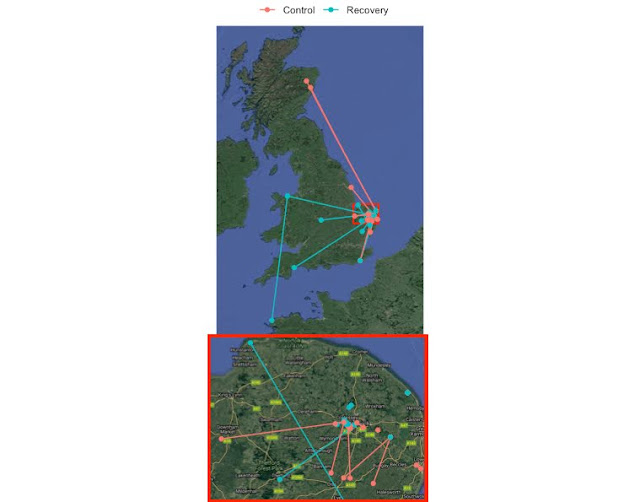










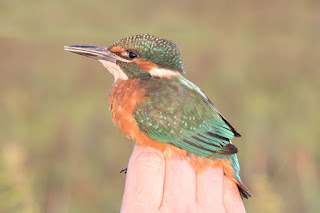


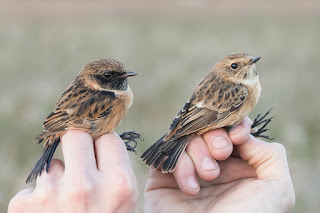
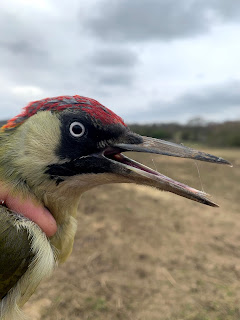




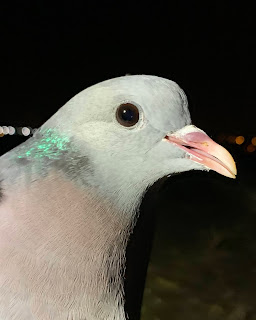
I'm a UEA Ecology student. How could I get involved? How do I get started with ringing?
ReplyDelete